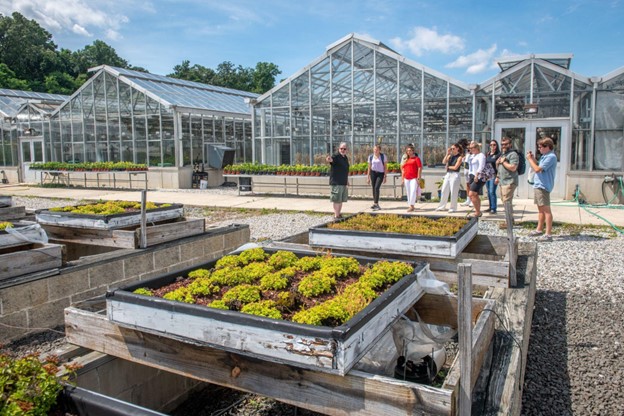Beverly Bolster is an undergraduate student at the University of Maryland and a guest contributor to this blog.
Earlier this year, Senators Heinrich (D-NM) and Braun (R-IN) introduced the Agrivoltaics Research and Demonstration Act of 2023 in the U.S. Senate to provide funding for the U.S. Departments of Energy and Agriculture to jointly research agrivoltaics. In the bill, an “agrivoltaic system” is defined as “a system under which solar energy production and agricultural production, including crop or animal production, occurs in an integrated manner on the same piece of land through the duration of a project.” The research would aim to determine the value of agrivoltaic systems and best practices for these operations, answering questions such as how solar panels should be configured or what crops should be grown. Because agrivoltaic systems have the potential to increase the production of renewable energy without losing existing farmland, the policies in this bill should be implemented through the next Farm Bill.
The Farm Bill Law Enterprise’s Climate and Conservation report advocates for sustainable farming to mitigate climate change. A model created by Oregon State University estimates that the U.S. could convert one percent of current farmland into agrivoltaics by investing only one percent of the federal budget and that this investment would be paid back within fourteen years through the energy savings generated. An additional study at this university found that by investing less than one percent of its annual budget into agrivoltaic infrastructure in rural areas, the U.S. could generate twenty percent of its needed electricity. Thus, agrivoltaics could be a compromise between increasing land available for solar generation without reducing existing farmland.
Instead of taking farmland out of production, this practice could actually increase farm viability. Agrivoltaics can provide farmers with the means to meet their own energy needs and, in some cases, to sell additional energy production back to the grid, thus saving or potentially generating extra money for farmers.
For agrivoltaics to work most efficiently, farmers and solar developers need to know the best configurations and practices. Existing research has shown that agrivoltaics can mutually benefit solar and agricultural production. In Arizona, researchers grew tomatoes and peppers under solar panels and found that this benefitted both the crops and the efficiency of the solar panels. The solar panels shaded the crops, reducing the stress on the plants due to drought and preventing them from losing as much water. This increased the production of the crops. In addition, the plants, by still giving off some water through transpiration, cooled the solar panels, enabling them to produce energy more effectively. Solar panels decrease in efficiency by 0.1 to 0.5% per every degree that they heat to above 25 degrees Celsius, so vegetation could be particularly useful in hot areas where solar panels are likely to overheat.
However, further research needs to assess how agrivoltaics can operate with other crops, in other locations, and at different scales. By funding research to determine the most efficient and effective implementations of agrivoltaic systems through the next Farm Bill, legislators have the power to advance agrivoltaics and move the U.S. closer to meeting our climate and renewable energy goals.
The views and opinions expressed on the FBLE Blog are those of the authors and do not necessarily reflect the official policy or position of FBLE. While we review posts for accuracy, we cannot guarantee the reliability and completeness of any legal analysis presented; posts on this Blog do not constitute legal advice. If you discover an error, please reach out to contact@farmbilllaw.org.
Photo credit: American Public Power Association

